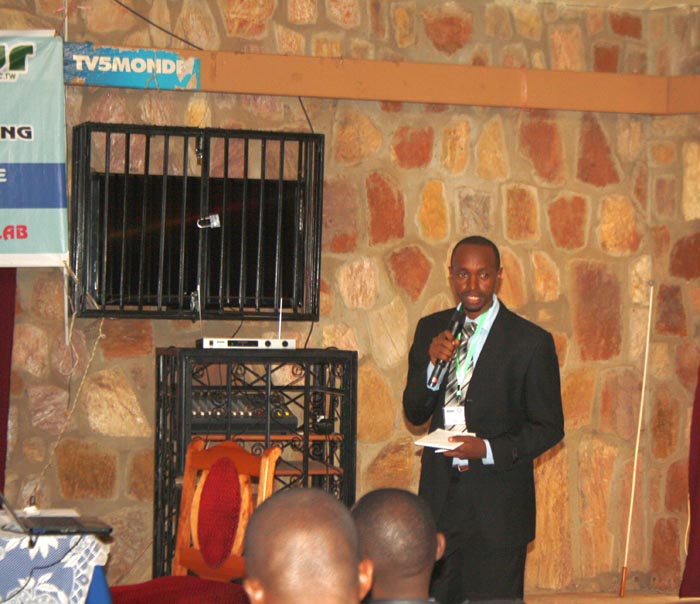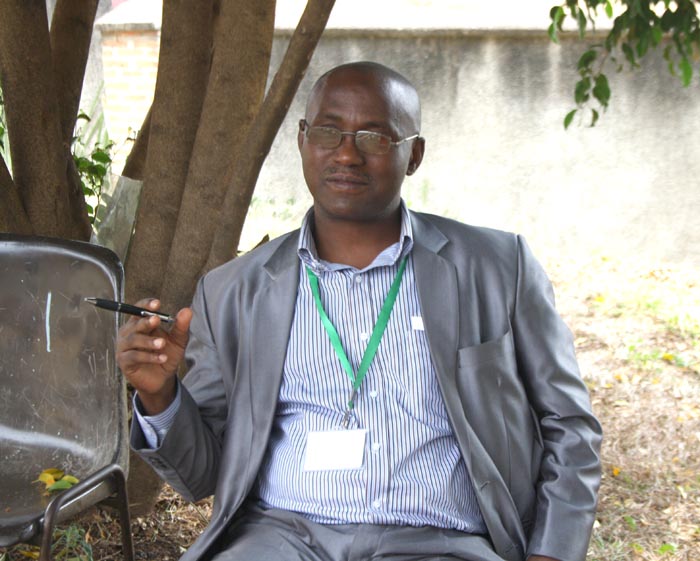The Regional Network for Conservation Educators of Albertine Rift (RNCEAR) 6th Annual Meeting has been recently held from 5th to 6th August 2013 at the University of Burundi. The main objective was the sensitization of community participation in climate change adaptation and areas conservation- by Lorraine Josiane Manishatse

Alain Kakunze: ““Activities such as bush fire, hunting, bamboo cutting, and fire wood collecting, wood for carpentry are the main threats of Burundi Protected Areas system” ©Iwacu
“Everybody is involved in safeguarding Protected Areas (PA) and participating in climate change adaptation is a must because climate change is now a global problem. Countries from Albertine Rift which are Burundi, Rwanda, Tanzania, Rwanda, Uganda and the Democratic Republic of Congo should share experiences and join their forces in climate change adaptation” indicates Brigitte Nyirambangutse, the RNCEAR Network Secretariat.
According to Alain Charles Kakunze, the former Rusizi National Park Responsible Officer, Burundi is one of the African Countries with a high rate of demography, something which is one of the degradation factors of Protected Areas. Deforestation and forest degradation are seen as key drivers of climate change.
“Activities such as bush fire, hunting, bamboo cutting, and fire wood collecting, wood for carpentry are the main threats of Burundi Protected Areas system” he deplores.
For Déo Tuyisenge, Lecturer at the National University of Rwanda, climate change is due to environmental factors. It has been observed that the water table is declining in the region which might lead to the fragmentation of wetlands, fragmentation of bamboo zone and bush fire.
A study was carried out in December 2012 in Volcanoes National Park (VNP) and Mgahinga National Park (MGNP) in Rwanda and it has been observed that agricultural activities around PA may reduce soil moisture and leaf decomposition and may increase the rate of evaporation and this may cause the water loss.
According to Marshall Banamwana, Lecturer at Kitabi College of Conservation and Environmental Management in Rwanda, Gishwati Forest Reserve is more threatened by human activities such as mining activities, tree cutting, cattle grazing, charcoal burning and natural destruction like soil erosion.
In Serengeti and Ngorongoro Districts in Tanzania, there is a conflict between human and small mammals. People living near those PA earn incomes by selling products from the hunted small mammals particularly rabbits.
For Flora John Magige, Lecturer at the University of Dar Es Salam in Department of Zoology and Wildlife Conservation, as the World’s population increases, there is an increasing demand of spaces and resources.
Activities made to cope with the climate change
“We investigated the potential urban and peri- urban road-side plant nurseries
in Kampala District to contribute to plant conservation and human well-being in the face of climate change and habitat loss in Uganda” explains Edouard N Mwamvu, Lecturer at Makerere University in Kampala-Uganda in Department of Forestry, Biodiversity and Tourism.
According to Kakunze, in Burundi, actions of participating in climate change adaptation are only concentrated on sensitizing. Only forest conservation agents participate in reducing climate change effects in collaboration with a small number of people grouped into environmental clubs or associations.
Rwanda Government is reinstituting mechanisms of safeguarding PA. But for Banamwana, it is very important to begin first to sensitize the population about the importance of those activities and asks them their points of view because the community participation plays a great role in achieving the goal.
Mohamed Feruzi, Managing Director of INECN (National Institute for Environment and Nature Conservation), admits that they collaborate with
community associations in safeguarding Protected Areas.
“We can’t succeed to save the Protected Areas without involving the community members. It is thanks to their effort and involvement that Bururi and Karonda reserves are now in a good situation. But there is still much to do because today Ruvubu and Kibira National Parks are getting burned. We plan to collaborate much more with local communities and associations for the safeguard of Protected Areas,” he concludes.















 IWACU Open Data
IWACU Open Data

